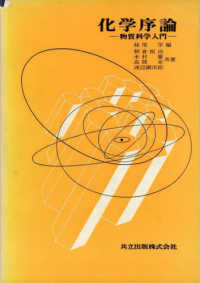- ホーム
- > 洋書
- > 英文書
- > Philosophy
Full Description
First Published in 1969, System, Structure and Experience offers a basic information-flow design capable of accounting for the complex operations of a culturally cognizant and purposive mind consistently with the general relationship of the human organism and its environment. By means of the isomorphy of a hierarchically ordered series of circuits, a way is opened for resolving the traditional 'mind- body' or 'psycho-physical' problems. The work outlines the design of a self-stabilizing and self-organizing system, shows that it applies to artificial, biological as well as cognitive structures, and then undertakes to analyze the diverse facets of perpetual, scientific, aesthetic, and religious experience in its terms. The interrelation of the two or more such multi-level cognitive systems offers insights into the problems of human communication.
The book is a contribution to the scientific analysis of cognitive experience and promotes the transfer of the traditional domain of an introspectively founded philosophy of mind into the realm of modern system research.
Contents
Preface 1. Basic Information-flow Design for Self-stabilizing Self-organizing Systems 2. The System- theoretical Analysis of Experience 3. Levels of Controlled Information-flow in Experience 4. Multilevel Interpersonal Communication 5. Values in Cognitive Communication 6. Conclusions Appendix-Further Notes on the Perception of Invariant Intelligible Gestalten Index







